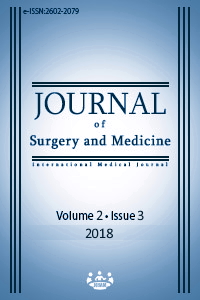Life-threatening isosulfan blue induced anaphylaxis during laparoscopic hysterectomy
Keywords:
Anaphylaxis, Sentinel lymph node, Hysterectomy, Isosulfan blueAbstract
The use of blue dye alone is the first described technique for sentinel lymph node (SLN) identification in patients with cervical carcinoma. In this procedure, Isosulfan Blue (IB), Methylene Blue or Patent Blue is injected into each quadrant of the cervix. We present an anaphylactic reaction to IB in a patient who underwent a laparoscopic hysterectomy. Approximately 15 min after the dye injection, the patient developed hypotension (55/35 mmHg) with an increase in heart rate (120 beats/minute) and a decrease of pulse oximetry to 85%. She was treated successfully with ephedrine, adrenaline, and fluid administration. When sterile drapes were removed, blue urticarial rashes all over the body were detected. The operation was halted, and the patient was transferred to the intensive care unit (ICU). Almost 4 hours after injection of IB, she experienced a second attack of bronchospasm under mechanical ventilation. She recovered uneventfully and was discharged from the ICU. The patient was referred to a skin prick test which was positive for IB. SLN biopsy for cervical cancers may have an increased risk of anaphylaxis probability due to administered blue dyes. It is crucial that the medical staff involved in these procedures be aware of anaphylactic reactions. This case report highlights the necessity of close monitoring of these patients in both the intraoperative and postoperative periods.
Downloads
References
Lambaudie E, Collinet P, Narducci F, Sonoda Y, Papageorgiou T, Carpentier P, et al. Laparoscopic identification of sentinel lymph nodes in early stage cervical cancer: Prospective study using a combination of patent blue dye injection and technetium radiocolloid injection. Gynecol Oncol. 2003;89(1):84–7. doi: 10.1016/S0090-8258(03)00059-3
Plante M, Renaud M-C, Têtu B, Harel F, Roy M. Laparoscopic sentinel node mapping in early-stage cervical cancer. Gynecol Oncol. 2003 Dec;91(3):494–503. doi: 10.1016/j.ygyno.2003.08.024
Cabanas RM. An approach for the treatment of penile carcinoma. Cancer. 1977; Feb,39(2):456-66. doi: 10.1245/s10434-011-2036-1
Dargent D, Enria R. Laparoscopic assessment of the sentinel lymph nodes in early cervical cancer. Technique--preliminary results and future developments. Crit Rev Oncol Hematol. 2003;48(3):305–10. doi: 10.1016/S1040-8428(03)00129-X
Bézu C, Coutant C, Salengro A, Daraï E, Rouzier R, Uzan S. Anaphylactic response to blue dye during sentinel lymph node biopsy. Vol. 20, Surgical Oncology. 2011. doi: 10.1016/j.suronc.2010.10.002
Gil-Moreno A, Díaz-Feijoo B, Roca I, Puig O, Pérez-Benavente MA, Aguilar I, et al. Total laparoscopic radical hysterectomy with intraoperative sentinel node identification in patients with early invasive cervical cancer. Gynecol Oncol. 2005;96(1):187–93. doi: 10.1016/j.ygyno.2004.09.055
Albo D, Wayne JD, Hunt KK, Rahlfs TF, Singletary SE, Ames FC, et al. Anaphylactic reactions to isosulfan blue dye during sentinel lymph node biopsy for breast cancer. Am J Surg. 2001;182(4):393–8. doi: 10.1016/S0002-9610(01)00734-6
Leong SP, Donegan E, Heffernon W, Dean S, Katz JA. Adverse reactions to isosulfan blue during selective sentinel lymph node dissection in melanoma. Ann Surg Oncol. 2000;7(5):361–6. doi: 10.1007/s10434-000-0361-x
Sandhu S, Farag E, Argalious M. Anaphylaxis to isosulfan blue dye during sentinel lymph node biopsy. J Clin Anesth. 2005;17(8):633–5. doi: 10.1016/j.jclinane.2005.03.006
Beenen E, de Roy van Zuidewijn DBW. Patients blue on patent blue: An adverse reaction during four sentinel node procedures. Surg Oncol. 2005;14(4):151–4. doi: 10.1016/j.suronc.2005.12.001
Liang MI, Carson WE. Biphasic anaphylactic reaction to blue dye during sentinel lymph node biopsy. World J Surg Oncol. 2008;6. doi: 10.1186/1477-7819-6-79
Reed H, Shaw C, Rice M, Le HT. Isosulfan blue dye anaphylaxis presenting as impaired ability to ventilate via a laryngeal. Case Reports. 2014;3(1):1–2. doi: 10.1213/XAA.0000000000000036
Hepner DL, Castells MC. Anaphylaxis During the Perioperative Period. Anesth Analg. 2003;1381–95. doi: 10.1213/01.ANE.0000082993.84883.7D
Levy JH. Anaphylactic reactions. In: Barash PG, editor. Clinical Anesthesia. 7th ed. Philadelphia: LIPPINCOTT WILLIAMS & WILKINS; 2013. p. 287–302.
Lonjaret L, Lairez O, Minville V, Geeraerts T. Optimal perioperative management of arterial blood pressure. Integr Blood Press Control. 2014;7:49–59.
Harper NJN, Dixon T, Dugué, Edgar DM, Fay A, Gooi HC, et al. Guidelines suspected anaphylactic reactions associated with anaesthesia. Anaesthesia. 2009;64(2):199–211.
Raut CP, Hunt KK, Akins JS, Daley MD, Ross MI, Singletary SE, et al. Incidence of anaphylactoid reactions to isosulfan blue dye during breast carcinoma lymphatic mapping in patients treated with preoperative prophylaxis: Results of a surgical prospective clinical practice protocol. Cancer. 2005;104(4):692–9. doi: 10.1002/cncr.21226
Vokach-Brodsky L, Jeffrey SS, Lemmens HJM, Brock-Utne JG. Isosulfan blue affects pulse oximetry. Anesthesiology. 2000;93(4):1002–3. PMID: 11020754
Ortiz D, Alvikas J, Riker AI. A Case of Severe Anaphylactic Reaction Secondary to Isosulfan Blue Dye Injection. Ochsner J. 2015;15(2):183–6.
Howard JD, Moo V, Sivalingam P. Anaphylaxis and other adversereactions to blue dyes: a case series. Anesth Intensive Care.2011;39:287-92.
Brenet O, Lalourcey L, Queinnec M, et al. Hypersensitivity reac-tions to Patent Blue V in breast cancer surgery: a prospectivemulticentre study. Acta Anesthesiol Scand. 2013; 57:106-11.
Downloads
- 1394 1728
Published
Issue
Section
How to Cite
License
Copyright (c) 2018 Melike Korkmaz Toker, Başak Altıparmak, Mustafa Turan, Bakiye Uğur, Semra Gümüş Demirbilek
This work is licensed under a Creative Commons Attribution-NonCommercial-NoDerivatives 4.0 International License.















